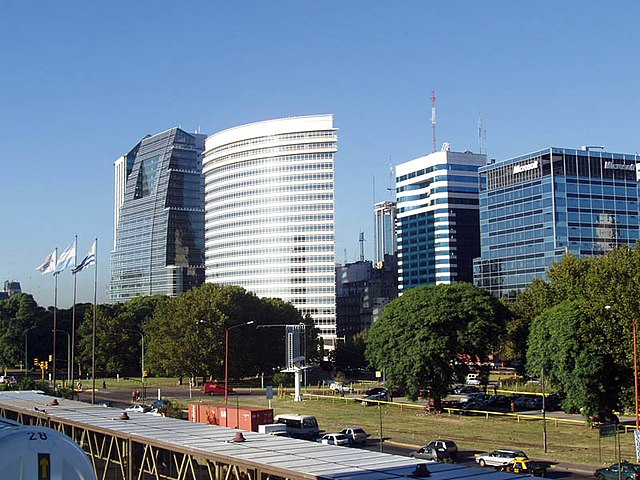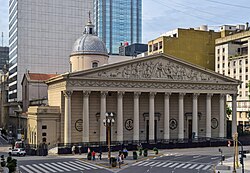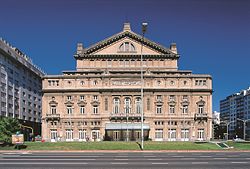Buenos Aires
capital and largest city of Argentina From Wikipedia, the free encyclopedia
Remove ads
Buenos Aires is the capital and largest city in the South American country of Argentina. It has its own executive, legislative and judicial powers. It is in the central-eastern region of the country, on the southern shore of the Río de la Plata, in the Pampas region. The city was ceded in 1880 by the Province of Buenos Aires to be the federal capital of the country. It is the "main capital", along with 24 alternate capitals, because of the constitutional reform of 1994. Buenos Aires city is also known as Capital Federal to differentiate the city from the Buenos Aires Province. Until 1994 Buenos Aires city was under the presidential government, but after a constitutional reform in that year, the city became self-governed, allowing citizens to elect their city authorities.

Remove ads
Population
3,040,000 people live in Buenos Aires. Spanish is the main language, but English is widely spoken and understood well. Italian is also widespread.
Climate
Buenos Aires has a humid subtropical climate (Köppen climate classification: Cfa). The average temperature is 17 °C. During the 20th century the temperature went up because of the urbanization. Rainfall is 1222.6 mm. per year. Summers are hot and humid. Winters are mild, the highest medium temperature is 13.7 °C during this season. Temperature rarely reaches 0 °C or below. Fog is frequent. Snow is extremely rare, and falls once or twice in a century.
Snow is very rare in the city: the last snowfall happened on 9 July 2007 when, during the coldest winter in Argentina in almost 30 years, severe snowfalls and blizzards hit the country. It was the first major snowfall in the city in 89 years.[5][6]
Remove ads
Neighborhoods
Buenos Aires is divided into 48 neighborhoods. Most populated areas are:
- Palermo: Located in the northeast of the city, it also is the largest neighborhood in Buenos Aires. Some parts of Palermo are highly touristic: Bosques de Palermo (Palermo Woods), Palermo Soho, Palermo Hollywood
- Caballito: This mostly residential neighborhood is located in the geographical centre of the city.
- Recoleta: Recoleta is one of the most wealthy neighborhoods in Buenos Aires. Recoleta Cemetery is located there.
Tourism
Buenos Aires is the most visited city in South America.[9] The most touristic areas are the historical center, Palermo, Recoleta and San Telmo. In 2005, because of the city's architecture and fashion design culture, Buenos Aires was appointed as the first UNESCO City of Design,[10] and received this title once again in 2007.[11]
- Historical Center / Plaza de Mayo: It is the historical place of the foundation of the city. On Plaza de Mayo, many interesting buildings can be found : Cabildo (where the colonial government was), Cathedral, Casa Rosada (current Government Palace).
- San Telmo is one of the most ancient neighborhoods in Buenos Aires. It used to be a very expensive area. But in the 18th Century, an epidemic made people move to Recoleta area, farther from the river.
- Recoleta: In this neighborhood, there are many beautiful Palaces from the 19th Century. Tourists also visit Recoleta Cemetery where many political figures are buried. One famous person buried in Recoleta Cemetery is political woman Eva Perón.
- Palermo: Palermo is divided in several sub-areas. Palermo Soho is full of designers and clothing shops. Palermo Hollywood is the gastronomical heart of Buenos Aires.
- Boedo: Classical and very interesting tango and literature historical district. A remarkable episode in the Argentine literature's history is the social and literary dialogue between the Florida Group, named this way because its members used to meet up at the Richmond Cafeteria at Florida street and publish their work in the Martin Fierro magazine, like Jorge Luis Borges, Leopoldo Marechal, Antonio Berni (artist), among others, versus the Boedo Group of Roberto Arlt, Manzi and other writers and artists. They used to meet together at the Japanese Cafe and published their works with the Editorial Claridad, with both the cafe and the publisher located at the Boedo Avenue.
Remove ads
Wikimania
References
Other websites
Wikiwand - on
Seamless Wikipedia browsing. On steroids.
Remove ads












